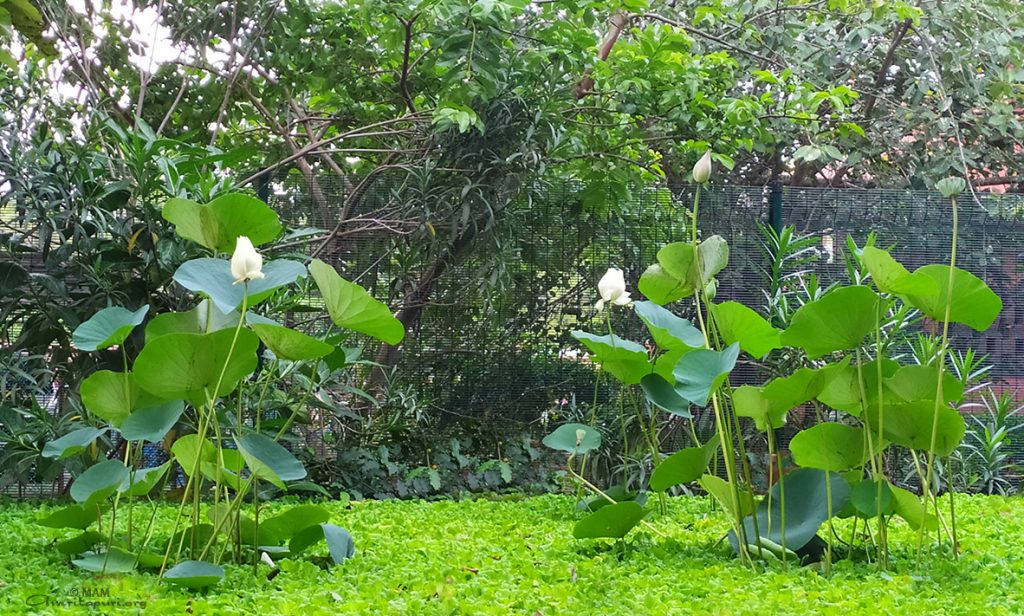Guru Pada Padma: Amma’s Lotus Feet

Lakshmi Devi, Durga Devi and Saraswati Devi inside Amritapuri’s Kali Temple…
Amritapuri is very much God’s Own Island.
The oleographs of goddesses from the works of the legendary artist, Raja Ravi Verma of 19th century Kerala, have made a deep impress on the collective minds of Indians about how the Devis, elaborately described and praised in Sanskrit literatures, really would look like: Lakshmi and Saraswati Devis are in the foreground, and Nature in all Her abundance covers every inch of the canvas: the green woods, flowering bushes, flowing waters, sporting birds, and, Lotuses. Amma says such depiction shows that God is one with Nature, not separate from Nature.
Amma’s Devi bhava gave us opportunity to see Devi in the very context as in the collective memory. There have been many water spots in the ashram surrounding, with white or pink or blue lotuses, big and small, shining out of them. There have been many singing birds, water birds, occasional peacocks, elephants, et all in the ecosystem. And in the midst of this natural setting, Amma shines in Devi bhava for the world to see!
There have been beautiful lotuses in the pond by the kutil (darshan hut). With changes in surroundings, new and novel ponds have come up in several places where today varieties of lotuses that bloom at different times of dawn and dusk are raised.
Lotus, the National Flower of India, has travelled far and wide as an important motif in Indian temple architecture. All temples big and small have lotus imagery in the pillars and/or roof and anywhere possible.
Lotuses are of spiritual significance in all religions of this land. Profound philosophies are explained in terms of Lotuses of varying number of petals and sizes, in Jainism and in Buddhism. The Kundalini Yoga practiced for unfolding the energy within, speaks of lotuses as located at energy centers along the spine: five petals at Mooladhara, to two at Ajna and thousand petals at Sahasrara. In Lalita Sahasra Nama, Devi is called Sahasrarambujarudha, one who is seated on the thousand petalled lotus; here thousand suggests ‘innumerable’, obviously a reference to Her Omnipotence. What an exhilarating experience to feel several lotuses blooming within oneself!

A lotus pond at Amritapuri
Lord Brahma the Creator according to Puranas is said to have originated from the lotus that emerged from Lord Narayana’s navel. In Puranas we see many gods wielding lotus in a hand. In stutis, Devis are described as those with lotus like hands, karakamale, lotus like eyes, kamalanayane, lotus like face, kamalamukhi, and even as one seated on lotus, kamalaasane ! Kamala is the Sanskrit general term for Lotus, just as Lotus is a generic term for a pack of similar water flowers. Devotional poetry speaks untiringly of Hridayakamala, the heart-lotus of the devotee where the Ishtadevata resides.
However, the most magnanimous of these descriptions is of the Lotus Feet of The Guru, Gurupaadapadma, where the lotus represents Purity and Transcendence, the supreme qualities of the Master. At the same time for the disciple, Guru is also the Spiritual Sun that makes his/her heart lotuses blossom. A Swamini recently said in her satsang: It is only in Amma’s Love shine that we develop and we sustain our love for Her.
As Amma reminds us, Lotus blooms with Sun rise, and droops after sun sets. Even though it is in mire, it is tuned to none other than the Sun, the noblest ideal! Distance doesn’t matter. This is the greatest symbol of Pure Love.

A white lotus turns towards the sun in one of Amritapuri’s ponds

A pink water lily in one of Amritapuri’s ponds

A little fish visits a blue water lily in one of Amritapui’s ponds
Yet lotus is humble in the sense that it doesn’t mind growing in mire. A Guru is Lotus Himself. He doesn’t belong here, yet is here, for our sake.
Just as lotus stands for the Ideal, lotus also provides metaphor for the path, for the disciple to reach the ideal. Guru is always striving to unite his disciple with Himself and so, as easily as He (here, Amma) shares his peetham with Shakti the dog, the Symbol of Lotus appropriates both the Goal and the path. In Ultimate Union everything becomes equally holy.
Lotus leaves are a metaphor for vairagya or detachment. The plant is born in water, lives in water, yet remains untouched by it. In fact, it is a technique to live simply and meaningfully. Let the boat be in water but do not let water seep into the boat, says Amma.
The lotus stalk is upright. In the Shivalinga pond one can see the pink little lotus standing by the Trishul, equally upright, strong and committed. The precept here for a spiritual seeker: one should rise from one’s past however murky it may have been, and reach out to the Spiritual Sun.
Amma Bhajans have innumerable references to flowers, especially lotus. Over 22 synonyms of lotus, like kamala, taamara, taavare, kumuda, ambuja, pankaja, neeraja, padma, vaarija, aravinda, utpala, kuvalaya, sarasija, saroruha, sarasiruha, pankeruha, raajiva, indeevara, nalini, mrinalini, amboruha, pundarika are all found in Her bhajan litany.
Amma’s Loving Form with white attire is so akin to white lotus, for anybody to feel. Amma’s touch -so easily offered to millions in plenty, globe over- is rare and special and soft like the touch of a heavenly Lotus. At the same time, even amidst hundreds, Amma’s Form glows like the Sun with unmistakable Spiritual Light. She is indeed Love and Light.

A drawing of Amma with Lotus flowers…
Guru Poornima is the most auspicious day for offering our heart flowers at Amma’s Lotus Feet.
Swamiji, Amma’s foremost disciple, once said in a mood of reverie, that he was a tiny flower adorning Amma’s hair… he decided to Meet and Merge in Amma’s Feet and came down… and now he is yearning and searching for Her Lotus Feet.
May we all too pursue the ideal of meeting and merging in Amma’s Lotus Feet.


Leave a Reply
You must be logged in to post a comment.